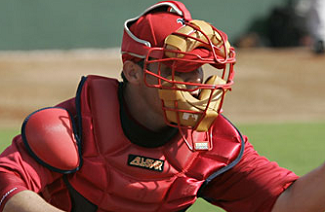The baseball catcher is one of the most dangerous positions in sports.

This person is tasked with catching pitches that can reach speeds of 100 miles per hour. He is also tasked with using his body to block those pitches. The catcher is not only supposed to be able to stop a ball hurling toward him at deadly speeds, but to also dodge the swing of the bat.
Oddly the first baseball catchers did not use any safety equipment; they actually caught pitches with their bare hands. But as pitches got faster, the need for protective equipment arose, including the mitt, chest protector, and face mask. The glove and other padded equipment has not changed too much over the years, but the face mask has. The traditional face mask is slowly being replaced by the hockey-style mask, but is the traditional face mask still a safe option? Let’s look at the pros and cons of using the traditional, cage-style mask. The cage-style mask has been used by catchers for a handful of reasons.
Advantages

First, it is affordable – especially when compared to the hockey-style mask. The cage mask does not sit too close to the face, which offers comfort to many players. However, there are some players who do not like how far the mask actually sits off of the face. The mask is easy to take on and off, especially when the catcher has to catch a foul pop up. And, on the hot days of summer, the cage mask keeps the face cool.
The cage mask offers protection in a way the hockey mask does not. When the catcher needs to take off the mask to catch a pop-up, the hockey mask needs to be fully removed. This is not the case with the cage mask. The catcher simply pushes the cage up to the top of the head. The mask does not have to be fully removed, so there is still head protection for the catcher with the cage mask.
Disadvantages
On the flip side, the cage mask does offer some disadvantages. The first is the lack of protection. While it does offer protection on the front of the face, the back of the head and the sides of the head are not well-protected. After catchers use the hockey-style mask, the often complain about the way the cage mask does not offer the same view of the field.
The disadvantages with the cage mask mostly involve the lack of side face protection. When a batter swings, there is a small chance that the side of the face can be hit by the backswing. With the hockey mask, the entire head is covered. But, even with a hockey mask, the risk of concussion still exists if the mask is hit by a bat being swung at full strength.
More about Field View

When it comes to the view of the field, the hockey mask gives more of a view. Of course, a cage mask does give a full view of the field, but the cage does obstruct certain areas depending on where the catcher is looking. It is important to consider the fact that the catcher should be able to see the entire field – since he is the only player who actually can see it. The hockey mask performs better than the cage mask in this area.
Comfort considerations
Another vital aspect of the catcher’s mask to consider is comfort. The only person who can judge this is the catcher. When it comes to the heat of the sun during a game in the middle of July, the hockey mask can become an oven on the inside. There is very little ventilation inside of this type of mask. On the flip side, the cage mask is open, so the face and the rest of the head has exposure to breezes and anything else that can keep it cool in the hot summer days. There are catchers who love the containment of the hockey mask and there are other who cannot stand it.
More on versatility

When it comes to being able to easily put on and take off the mask, this is, again, the preference of the catcher. The hockey mask is very easy to put on, because it is designed to go on from the back to the front. The back extends a little so the front can be pulled down – it’s similar to putting on a baseball hat and it can be done with one hand. The cage mask is a bit more complicated at first and it usually requires two hands until the catcher gets used to putting it on and taking it off. There is a strap that goes behind the head and most catchers need to hold this in place as they put the front of the mask on.
Many catchers find that it is difficult to wear sunglasses while they wear a cage mask, because of the location of the bars. This often leads them to the hockey mask. Fortunately, manufacturers have begun making sunglasses that fit both types of masks.
When it comes to choosing a catcher’s mask, it comes down to comfort and safety. The catcher needs to decide what he likes the most about the different types of masks and what he feels the most comfortable wearing. It is a good idea to try out both styles during a live-game practice.
Comments are closed.